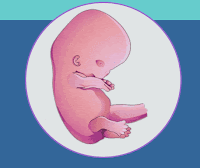1) All the following are derivatives of ectoderm, EXCEPT:
b) Cortex of suprarenal gland.
c) Sensory ganglia of spinal nerves.
d) Pituitary gland.
e) Retina of eye.
2) Regarding oogenesis, all statements are correct, EXCEPT:
a) It starts during fetal life.
b) It is completed during puberty.
c) It continues till menopause.
d) Primary oocytes are formed after birth.
e) The second meiotic division is completed after fertilization.
3) Regarding spermatogenesis:
a) It starts before birth.
b) Primary spermatocytes have a haploid number of chromosomes.
c) Spermiogenesis is a process by which a spermatid is transformed into a mature sperm.
d) Spermiogenesis occurs in the fallopian (uterine) tube.
e) The first meiotic division is a reduction division by which a secondary spermatocyte divides into two spermatids.
4) All the following are mesodermal derivatives, EXCEPT:
a) Bones
b) Kidneys
c) Enamel of teeth
d) Skeletal muscles
e) Dermis of skin
5) The skin:
a) Is derived from all the three germ layers
b) Is derived from the ectoderm & mesoderm
c) Is derived from endoderm
d) Has a superficial epithelial tissue called dermis
e) Has an epidermis composed of dense, irregularly arranged connective tissue
6) All the following muscles are derived from hypaxial division of myotome, EXCEPT:
a) Erector spinae
b) Infrahyoid muscles
c) Quadratus lumborum
d) Scalene muscles
e) Intercostal muscles
7) All the following are derivatives of mesonephric duct in male, EXCEPT:
a) Seminal vesicle
b) Prostate
c) Ductus deferens
d) Epididymis
e) Ejaculatory duct
8) Regarding the development of duodenum:
a) At first, the duodenal loop is concave forward
b) It is developed from midgut and hingut
c) Duodenal loop rotates 90˚ to the left
d) Recanalization of duodenal loop occurs by the end of embryonic period
e) All its ventral mesentery disappears
9) Regarding the development of vertebral column:
a) The centrum develops from two adjacent sclerotomes
b) The sclerotomes form the nucleus pulposus of intervertebral discs
c) The sclerotomes are only found around notochord
d) Ossification of a typical vertebra ends after birth
e) The costal processes are formed from mesenchymal cells surrounding the neural tube





It is very usseful knowledge.
ReplyDeletethanks for your helping us.
Thanks for sharing these embryology important questions with us. To get more information about embryology you need to read some embryology medical ebooks. For Medical students and doctors, afkebooks have a collection of mbbs books pdf. you can check it on our web portal.
ReplyDelete